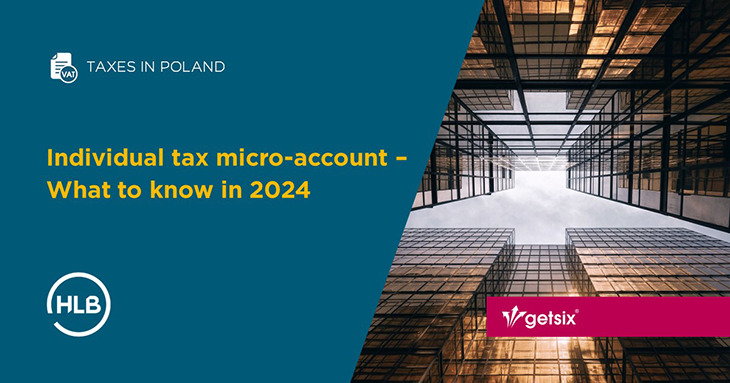Individual tax micro-account – What to know in 2024
What is an individual tax micro-account?
An individual tax micro-account serves as an individualized platform designed for making tax payments. Introduced on 1 January 2020, it was designed to streamline and simplify the process of tax payments. This system allows both taxpayers and employer-payors to make payments to the tax office in a more organized manner. The individual tax micro-account is exclusively dedicated to tax payments, and the procedures related to refunds and tax returns remain unchanged, in accordance with the existing rules.
Who has an individual tax micro-account?
The individual tax micro-account, dedicated to both individuals and businesses, was created to facilitate the fulfilment of financial obligations, minimizing the risk of errors such as an incorrect description of a transfer or other potential mistakes.
What payments are made through the individual tax micro-account?
Initially, taxpayers made payments of personal income tax (PIT), corporate income tax (CIT) and value added tax (VAT) to the micro-account. The catalogue of tax receivables has been updated over the years. As of 1 January 2024, gaming tax (POG), gaming surcharges (GHD) and VAT on intra-Community acquisition of motor fuels (VAT-14) have been added to the catalogue.
Currently, based on the regulation of the Minister of Finance of 22 December 2023 (Journal of Laws 2023, item 2802), taxpayers are required to pay into a tax micro-account:
- Corporate Income Tax
- Personal Income Tax
- Value Added Tax
- Retail Sales Tax
- Tax on Extraction of certain Minerals
- Gambling Tax
- Surcharge on number games, cash lotteries and telebingo games
- Solidarity Surcharge
- Excise tax on Alcoholic Beverages in Packaging up to 300 ml
- Food tax
- Fee paid by entities providing a service that is an advertisement for alcoholic beverages
- Fee for providing information to court bailiffs
- Fee for issuing an extract from the register of treasury pledges or a certificate as referred to in Article 46c § 2 of the Act of August 29, 1997
A full list of payments made using the individual tax micro-account, including form symbols and payment titles, can be found in the appendix to the Regulation of the Minister of Finance dated December 22, 2023 (Journal of Laws 2023, item 2802).
How to check the individual tax micro-account number?
The first way is to visit the tax office, where an employee will provide the necessary information. The second way is to visit the individual tax micro-account generator’s website and enter the correct number:
- in the case of natural persons who do not conduct business and are not registered for VAT, the PESEL number must be used.
- in the case of sole traders who are subject to VAT or pay taxes, social security contributions and health insurance, the NIP number must be used.
The advantage of generating an individual tax micro-account is its simplicity. All necessary information can be obtained by using any device with internet access. In addition, there is no need to worry about losing the individual tax micro-account number, as it can be checked at any time, ensuring that payments reach the correct destination. The system operates 24/7 and is available free of charge. Furthermore, the individual tax micro-account number is permanent, regardless of any changes in residence, tax office, or surname.
To generate the individual tax micro-account number, it is recommended to use only the official website provided by the Ministry of Finance, which is podatki.gov.pl. In addition, caution is advised when using account numbers sent via email or SMS.
What if you don’t have a NIP and PESEL number?
In situations where a taxpayer does not have NIP or PESEL number, but holds taxpayer status in Poland, they should have a tax ID. If the taxpayer is awaiting a decision on the allocation of an identification number, they can safely make a payment to the individual tax micro-account of the relevant tax office, according to the announcement of tax office bank accounts. During the transfer, it is necessary to provide the number of an identity document, such as a passport or ID card. This allows the tax office to accurately identify the payer and correctly account for the payment.
What does an individual tax micro-account account number look like?
The individual tax micro-account is created from a sequence of 26 characters:
LK 1010 0071 222Y XXXX XXXX XXXX
- LK symbolizes the check digit
- the value 10100071 is a constant for each individual tax micro-account, representing the settlement number at the National Bank of Poland (NBP)
- the value 222 is a constant for each individual tax micro-account, indicating the complementary number at the NBP
- Y takes the value 1 when using the PESEL number or 2 when using the NIP number
- after the Y symbol, the PESEL or NIP number is entered
- subsequent positions in the sequence are filled with zeros to achieve a total length of 26 characters.
How to make a payment into the individual tax micro-account?
When making a tax payment via online banking, select the “tax transfer” option and provide:
- the number of the individual tax account identifying the taxpayer (individual tax micro-account)
- the amount of tax to be paid
- the period for which the payment is made (month, quarter, year)
- the symbol of the payment form, e.g., PIT-37.
Correctly describing the payment will help avoid complications when explaining the transaction to the tax office.
What if a transfer is made to an incorrect individual tax micro-account number?
In case of an error related to making a payment to the incorrect individual tax micro-account number, the taxpayer can take on the following steps:
- if the taxpayer realizes they have paid the amount into the wrong account, they should personally go to the relevant tax office, presenting proof of the transfer order and explaining the situation
- if the taxpayer is unaware that he has made a payment to the wrong account:
a) in a situation where there is no other taxpayer with a specific tax ID assigned, the tax office will contact the taxpayer to obtain explanations regarding the payment.
b) If the amount is credited to the account of another taxpayer, the taxpayer will receive a notice of tax arrears, in which it is recommended to report to the tax office with confirmation of the payment made. The tax office employee will be able to verify the data in the transfer order, which will facilitate the clarification of the matter.
In both cases, no negative consequences should result from these circumstances.
If you have any questions regarding this topic or if you are in need for any additional information – please do not hesitate to contact us:
CUSTOMER RELATIONSHIPS DEPARTMENT

ELŻBIETA NARON
Head of Customer Relationships
Department / Senior Manager
getsix® Group
***





